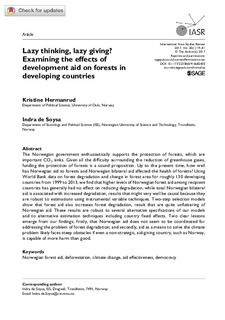| dc.contributor.author | de Soysa, Indra | |
| dc.contributor.author | Hermanrud, Kristine | |
| dc.date.accessioned | 2018-03-19T12:11:35Z | |
| dc.date.available | 2018-03-19T12:11:35Z | |
| dc.date.created | 2017-12-21T17:57:13Z | |
| dc.date.issued | 2017 | |
| dc.identifier.citation | International Area Studies Review. 2017, 20 (1), 19-41. | nb_NO |
| dc.identifier.issn | 2233-8659 | |
| dc.identifier.uri | http://hdl.handle.net/11250/2491018 | |
| dc.description.abstract | The Norwegian government enthusiastically supports the protection of forests, which are important CO2 sinks. Given all the difficulty surrounding the reduction of greenhouse gases, funding the protection of forests is a sound proposition. Up to the present time, how well has Norwegian aid to forests and Norwegian bilateral aid affected the health of forests? Using World Bank data on forest degradation and change in forest area for roughly 130 developing countries from 1999 to 2013, we find that higher levels of Norwegian forest aid among recipient countries has generally had no effect on reducing degradation, while total Norwegian bilateral aid is associated with increased degradation, results that might very well be causal because they are robust to estimations using instrumental variable techniques. Two-step selection models show that forest aid also increases forest degradation, result that are quite unflattering of Norwegian aid. These results are robust to several alternative specifications of our models and to alternative estimation techniques including country fixed effects. Two clear lessons emerge from our findings; firstly, that Norwegian aid does not seem to be coordinated for addressing the problem of forest degradation; and secondly, aid as a means to solve the climate problem likely faces steep obstacles if even a non-strategic, aid-giving country, such as Norway, is capable of more harm than good. | nb_NO |
| dc.language.iso | eng | nb_NO |
| dc.publisher | SAGE Publications | nb_NO |
| dc.title | Lazy thinking, lazy giving? Examining the effects of development aid on forests in developing countries | nb_NO |
| dc.type | Journal article | nb_NO |
| dc.type | Peer reviewed | nb_NO |
| dc.description.version | publishedVersion | nb_NO |
| dc.source.pagenumber | 19-41 | nb_NO |
| dc.source.volume | 20 | nb_NO |
| dc.source.journal | International Area Studies Review | nb_NO |
| dc.source.issue | 1 | nb_NO |
| dc.identifier.doi | 10.1177/2233865916682430 | |
| dc.identifier.cristin | 1531220 | |
| dc.description.localcode | © The Author(s) 2017 Reprints and permissions: sagepub.co.uk/journalsPermissions.nav | nb_NO |
| cristin.unitcode | 194,67,25,0 | |
| cristin.unitname | Institutt for sosiologi og statsvitenskap | |
| cristin.ispublished | true | |
| cristin.fulltext | original | |
| cristin.qualitycode | 1 | |
